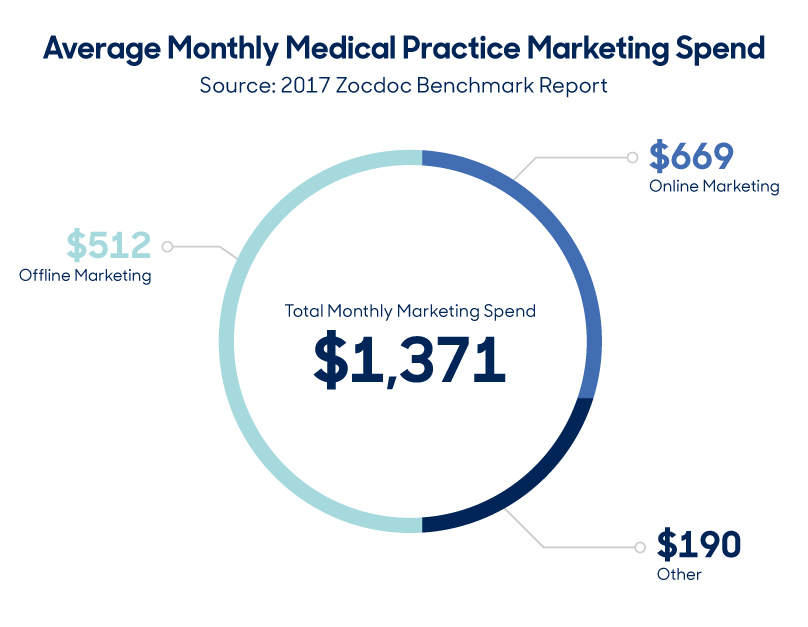When it comes to planning your annual practice budget, how much do you allocate for marketing? In our 2017 Benchmark Report we found that, among physicians and office managers surveyed, the average practice spent $1,371 on marketing each month. Of that amount, $669 went to digital marketing and $512 to offline marketing efforts.

We wanted to learn more about how much practices spend on marketing and where those dollars go. So we asked five doctors to break down their monthly budgets. Here’s what they told us.
Trent Douglas, MD
Plastic Surgeon
San Diego, California
Monthly marketing spend: $5,000–$10,000
Spending on marketing is a necessary business expense in today’s world of online advertising and optimized Google rankings. We track phone numbers specific to each campaign to determine effectiveness. Dollars go to website enhancements, advertising monthly specials, SEO, pay-per-click Google ads and print marketing. The monthly budget varies to account for hosting educational events and one quarterly event. Spending more for a newer practice of our size wouldn’t make a big difference, but we monitor our steady organic growth and projections over time. When that growth plateaus, we’ll revisit marketing initiatives and possibly increase the budget to reach the next level of growth.
Nicole Swiner, MD
Internist
Durham, North Carolina
Monthly Marketing Spend: $250–$300
A marketing budget is imperative in today’s tech-centric healthcare environment. A lot of patients look for information about your practice online and want to do background research. That means you need to advertise on a regular basis.
I personally take the lead for marketing and social media, writing posts and updating the practice website a few times a year. For the website, I work with a marketing consultant and graphic designers and gather new photos and headshots to keep everything looking fresh; these services cost between $500 and $1,000 each year.
If I write blog posts on hot topics in healthcare, such as women’s health, work-life balance or entrepreneurship, I’ll spend between $100 and $200 a month to boost them on social media. Marketing accounts for about 5 percent of my practice’s overall budget.
Narayanchar Murali, MD
Gastroenterologist
Brookdale, South Carolina
Monthly Marketing Spend: $18–$20
When I started my practice 25 years ago, I used to have an ad in the Yellow Pages. Later, I realized that outlay was expensive and useless. A few years ago, I stopped with the phone book and instead built my own website over one weekend. Now I pay $11 a month for web hosting and $72 every five years for my domain.
Anupama Verma, MD
Nephrologist
Green Bay, Wisconsin
Monthly Marketing Spend: $0
I am part of an independent nephrology group in a small city. There is also a second nephrology group affiliated with a large health system in our town. We personally have not felt the need for marketing and do not budget any money towards that. Instead, we rely on our work and word of mouth to speak for us, and so far, that has worked.
There was a time, many years ago, when we did have a slight slump in our practice. We noticed that patients were coming into our office for the first time with advanced kidney disease. So, we sent a letter out to our referring partners outlining the need for early detection and treatment of chronic kidney disease. The practice surged since then and has not let up yet.
M’liss Hogan, MD
Plastic Surgeon
Metairie, Louisiana
Monthly Marketing Spend: Undisclosed
Digital marketing, social media, and my website allow me to connect with patients wherever they are, whether that’s on a mobile phone, desktop or laptop. Time with my patients is my first priority but marketing is also important to the success of my practice. Because I don’t have marketing staff, I utilize a marketing company that specializes in healthcare, MOXY Company. Our strategy includes using social media and my website to engage, inform and interact with my patients. We believe a good marketing strategy speaks to people in ways they can understand — for example, simplifying medical terms that can be complicated. That helps develop trust between us. It also answers the initial questions they may have about plastic surgery so when we meet, we’re ready to discuss their specific needs.
![]()
